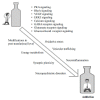Neuropharmacology of Alcohol Addiction with Special Emphasis on Proteomic Approaches for Identification of Novel Therapeutic Targets
- PMID: 35959616
- PMCID: PMC10193758
- DOI: 10.2174/1570159X20666220811092906
Neuropharmacology of Alcohol Addiction with Special Emphasis on Proteomic Approaches for Identification of Novel Therapeutic Targets
Abstract
Alcohol is a generic pharmacological agent with only a few recognized primary targets. Nmethyl- D-aspartate, gamma-aminobutyric acid, glycine, 5-hydroxytryptamine 3 (serotonin), nicotinic acetylcholine receptors, and L-type Ca2+ channels and G-protein-activated inwardly rectifying K channels are all involved. Following the first hit of alcohol on specific brain targets, the second wave of indirect effects on various neurotransmitter/neuropeptide systems begins, leading to the typical acute behavioral effects of alcohol, which range from disinhibition to sedation and even hypnosis as alcohol concentrations rise. Recent research has revealed that gene regulation is significantly more complex than previously thought and does not fully explain changes in protein levels. As a result, studying the proteome directly, which differs from the genome/transcriptome in terms of complexity and dynamicity, has provided unique insights into extraordinary advances in proteomic techniques that have changed the way we can analyze the composition, regulation, and function of protein complexes and pathways underlying altered neurobiological conditions. Neuroproteomics has the potential to revolutionize alcohol research by allowing researchers to gain a better knowledge of how alcohol impacts protein structure, function, connections, and networks on a global scale. The amount of information collected from these breakthroughs can aid in identifying valuable biomarkers for early detection and improved prognosis of an alcohol use disorder and future pharmaceutical targets for the treatment of alcoholism.
Keywords: Alcohol; G-protein; alcohol use disorder; neuroproteomics; neurotransmitters; pharmacological targets.
Copyright© Bentham Science Publishers; For any queries, please email at epub@benthamscience.net.
Conflict of interest statement
The authors declare no conflict of interest, financial or otherwise.
Figures
Similar articles
-
Proteomic approaches and identification of novel therapeutic targets for alcoholism.Neuropsychopharmacology. 2014 Jan;39(1):104-30. doi: 10.1038/npp.2013.182. Epub 2013 Jul 31. Neuropsychopharmacology. 2014. PMID: 23900301 Free PMC article. Review.
-
Neuropharmacology of alcohol addiction.Br J Pharmacol. 2008 May;154(2):299-315. doi: 10.1038/bjp.2008.30. Epub 2008 Mar 3. Br J Pharmacol. 2008. PMID: 18311194 Free PMC article. Review.
-
Neurobiological signatures of alcohol dependence revealed by protein profiling.PLoS One. 2013 Dec 16;8(12):e82656. doi: 10.1371/journal.pone.0082656. eCollection 2013. PLoS One. 2013. PMID: 24358215 Free PMC article.
-
NEUROBIOLOGICAL BASES OF ALCOHOL ADDICTION.Acta Clin Croat. 2016 Mar;55(1):134-50. doi: 10.20471/acc.2016.55.01.19. Acta Clin Croat. 2016. PMID: 27333729 Review.
-
Role of 5-hydroxytryptamine 1B (5-HT1B) receptors in the regulation of ethanol intake in rodents.J Psychopharmacol. 2013 Jan;27(1):3-12. doi: 10.1177/0269881112463126. Epub 2012 Oct 31. J Psychopharmacol. 2013. PMID: 23118018 Free PMC article. Review.
References
MeSH terms
Substances
LinkOut - more resources
Full Text Sources
Medical
Research Materials
Miscellaneous





